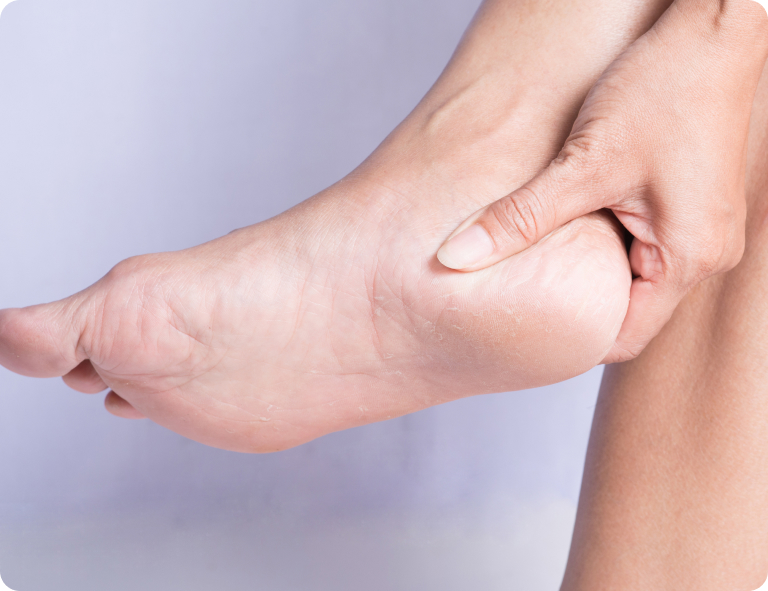Heel Disorders
Plantar fasciitis and heel spur syndrome result from inflammation of the ligament like tissue (the fascia) that stretches from the base of the toes, across the arch of the foot, to a point on the bottom of the heel bone. It is sometimes associated with a heel spur, in which case it is called “heel spur syndrome.” The condition can usually be successfully treated with conservative measures such as use of anti-inflammatory mediations and ice packs, stretching exercises, orthotic devices, and physical therapy. If the condition does not clear up after six months of these treatments, Extracorporeal Shock Wave Therapy may be considered. Sharp pain, aching or stiffness on the bottom of one or both heels is a very common ailment. The pain is often at its worst upon awakening in the morning (or after sitting down for an extended period and then resuming activity), causing hobbling or limping for a few minutes before a comfortable stride can be resumed. As weight continues to be applied during walking or standing, mild or severe pain may persist.5
When your first few steps out of bed in the morning cause severe pain in the heel of your foot, you may have plantar fasciitis (fashee-EYE-tiss). It’s an overuse injury affecting the sole or flexor surface (plantar) of the foot. A diagnosis of plantar fasciitis means you have inflamed the tough, fibrous band of tissue (fascia) connecting your heel bone to the base of your toes.

Who is more likely to get this Condition
You’re more likely to get the condition if you’re a woman, if you’re overweight, or if you have a job that requires a lot of walking or standing on hard surfaces. You’re also at risk if you walk or run for exercise, especially if you have tight calf muscles that limit how far you can flex your ankles. People with very flat feet or very high arches are also more prone to plantar fasciitis.
The condition starts gradually with mild pain at the heel bone often referred to as a stone bruise. You’re more likely to feel it after (not during) exercise. The pain classically occurs again after arising from a midday lunch break.
If you don’t treat plantar fasciitis, it may become a chronic condition. You may not be able to keep up your level of activity and you may also develop symptoms of foot, knee, hip and back problems because of the way plantar fasciitis changes the way you walk.
Treatments
Rest is the first treatment for plantar fasciitis. Try to keep weight off your foot until the inflammation goes away. You can also apply ice to the sore area for 20 minutes three or four times a day to relieve your symptoms. Often a doctor will prescribe nonsteroidal anti-inflammatory medication such as ibuprofen. A program of home exercises to stretch your Achilles tendon and plantar fascia are the mainstay of treating the condition and lessening the chance of recurrence.
In one exercise, you lean forward against a wall with one knee straight and heel on the ground. Your other knee is bent. Your heel cord and foot arch stretch as you lean. Hold for 10 seconds, relax and straighten up. Repeat 20 times for each sore heel.
In the second exercise, you lean forward onto a countertop, spreading your feet apart with one foot in front of the other. Flex your knees and squat down, keeping your heels on the ground as long as possible. Your heel cords and foot arches will stretch as the heels come up in the stretch. Hold for 10 seconds, relax and straighten up. Repeat 20 times.
About 90 percent of people with plantar fasciitis improve significantly after two months of initial treatment. You may be advised to use shoes with shock-absorbing soles or fitted with a standard orthotic device like a rubber heel pad. Your foot may be taped into a specific position.
If your plantar fasciitis continues after a few months of conservative treatment, your doctor may inject your heel with steroidal anti-inflammatory medications (corticosteroid). If you still have symptoms, you may need to wear a walking cast for 2-3 weeks or positional splint when you sleep. In a few cases, you might need surgery to release your ligament.
Heel disorders in Southern California can be treated by Beverly Hills Physicians, whose offices are located all over Los Angeles, including Beverly Hills, Encino, Thousand Oaks, Valencia, Pasadena and Oxnard.
1 www.footandankle.md.com 2 www.stoneclinic.com 3 www.footankle.com 4 www.podiatryonline.com
5 www.footankleinstitute.com 6 www.ucsfhealth.org 7 orthopedics.about.com 8 medlineplus medical encyclopedia
